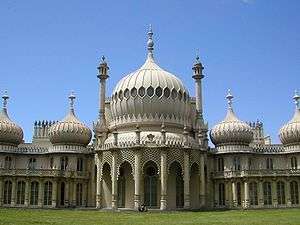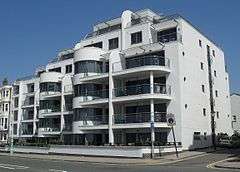Royal Suspension Chain Pier
Coordinates: 50°49′06″N 0°07′51″W / 50.81833°N 0.13083°W





The Royal Suspension Chain Pier was the first major pier built in Brighton, England.
History
Generally known as the Chain Pier, it was designed by Captain Samuel Brown rn and built in 1823.[1] Brown had completed the Trinity Chain Pier in Edinburgh in 1821.[2] The pier was primarily intended as a landing stage for packet boats to Dieppe, France, but it also featured a small number of attractions including a camera obscura. An esplanade with an entrance toll-booth controlled access to the pier which was roughly in line with the New Steine. Turner and Constable both made paintings of the pier, King William IV landed on it, and it was even the subject of a song.
The Chain Pier co-existed with the later West Pier, but a condition to build the Palace Pier was that the builders would dismantle the Chain Pier. They were saved this task by a storm which destroyed the already closed and decrepit pier on 4 December 1896.
The remains of some of the pier's oak piles, sunk ten feet into bedrock, can still be seen at the most extreme low tides. Masonry blocks can also be seen. The entrance kiosks and signal cannon of the pier are still intact, and are now used as small shops on the Palace Pier. The plaque commemorating this has been removed from the kiosks, but remains on the cannon.
On 5 September 2010, the Mayor of Brighton & Hove City Council unveiled a replica tablet commemorating the Chain Pier. The tablet is fixed to the wall along Max Miller Walk exactly opposite the site of the Pier. Brighton & Hove City Council & the Max Miller Appreciation Society jointly funded the tablet, which replaces an original tablet that went missing some years ago.
See also
![]() Media related to Royal Suspension Chain Pier at Wikimedia Commons
Media related to Royal Suspension Chain Pier at Wikimedia Commons
References
- ↑ Drewry, Charles Stewart (1832). A Memoir of Suspension Bridges: Comprising The History Of Their Origin And Progress. London: Longman, Rees, Orme, Brown, Green & Longman. pp. 69–74, Plate V. Retrieved 2009-06-13.
- ↑ Skempton, A. W. (2002). A Biographical Dictionary of Civil Engineers in Great Britain and Ireland: 1500–1830. Thomas Telford. pp. 86–87. ISBN 978-0-7277-2939-2.
External links
- Pictures and Drawings of the pier - from "Science and Society Picture Library"
- Photographs of the pier
- My Brighton and Hove resources related to the pier
- thisbrighton.co.uk - Brighton's Piers History
- Brighton Chain Pier and Remains (flickr gallery)

.jpg)
.jpg)
